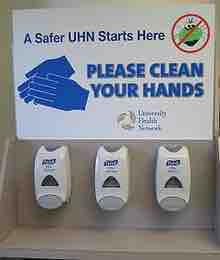Public Health Measures
The focus of public health intervention is to improve health and quality of life through the prevention and treatment of disease and other physical and mental health conditions. This can be done through surveillance of cases, and the promotion of healthy behaviors. Promotion of hand washing and breastfeeding, delivery of vaccinations, and distribution of condoms to control the spread of sexually transmitted diseases, are examples of common public health measures.
HAND WASHING
Hand washing for hand hygiene is the act of cleaning the hands with or without the use of water or another liquid, or with the use of soap, for the purpose of removing soil, dirt, and/or microorganisms . Medical hand hygiene pertains to the hygiene practices related to the administration of medicine and medical care that prevents or minimizes disease and the spreading of disease. The main medical purpose of washing hands is to cleanse the hands of pathogens (including bacteria or viruses) and chemicals, which can cause personal harm or disease. This is especially important for people who handle food or work in the medical field, but it is also an important practice for the general public. People can become infected with respiratory illnesses, such as influenza or the common cold; for example, if they don't wash their hands before touching their eyes, nose, or mouth. Indeed, the Centers for Disease Control and Prevention (CDC) has stated: "It is well documented that one of the most important measures for preventing the spread of pathogens is effective hand washing. "

Hand Cleaning Station
A hand cleaning station at the entrance of the Toronto General Hospital
As a general rule, however, handwashing protects people poorly or not at all from droplet- and airborne diseases, such as measles, chickenpox, influenza, and tuberculosis. It protects best against diseases transmitted through fecal-oral routes (such as many forms of stomach flu) and direct physical contact (such as impetigo). In addition to hand washing with soap and water, the use of alcohol gels is another form of killing some kinds of pathogens and healthful bacteria, but their effectiveness is disputed, and may lead to antibiotica-resistant bacterial strains.
BREASTFEEDING
Breastfeeding is the feeding of an infant or young child with breast milk directly from female human breasts (i.e., via lactation) rather than from a baby bottle or other container. Babies have a sucking reflex that enables them to suck and swallow milk. It is recommended that mothers breastfeed for six months or more, without the addition of infant formula or solid food. After the addition of solid food, mothers are advised to continue breastfeeding for at least a year, and can continue for two years or more. Human breast milk is the healthiest form of milk for babies. There are few exceptions, such as when the mother is taking certain drugs or is infected with human T-lymphotropic virus, or has active untreated tuberculosis. Maternal HIV infection is always an absolute contraindication to breastfeeding in developed countries with access to infant formula and clean drinking water (regardless of maternal HIV viral load or antiretroviral treatment) due to the risk for mother to child HIV transmission. Breastfeeding promotes health and helps to prevent disease. Artificial feeding is associated with more deaths from diarrhea in infants in both developing and developed countries. Experts agree that breastfeeding is beneficial, and have concerns about artificial formulas but there are conflicting views about how long exclusive breastfeeding remains beneficial.
VACCINATION
Vaccination is the administration of antigenic material (a vaccine) to stimulate an individual's immune system to develop adaptive immunity to a pathogen. Vaccines can prevent or ameliorate morbidity from infection. The effectiveness of vaccination has been widely studied and verified; for example, the influenza vaccine, the HPV vaccine, and the chicken pox vaccine. Vaccination is the most effective method of preventing infectious diseases; widespread immunity due to vaccination is largely responsible for the worldwide eradication of smallpox and the restriction of diseases such as polio, measles, and tetanus from much of the world.
CONDOMS
A condom is a barrier device commonly used during sexual intercourse to reduce the probability of pregnancy and spreading sexually transmitted diseases. It is put on a man's erect penis and physically blocks ejaculated semen from entering the body of a sexual partner. Condoms are also used for collection of semen for use in infertility treatment. In the modern age, condoms are most often made from latex, but some are made from other materials such as polyurethane, polyisoprene, or lamb intestine. A female condom is also available, often made of nitrile.